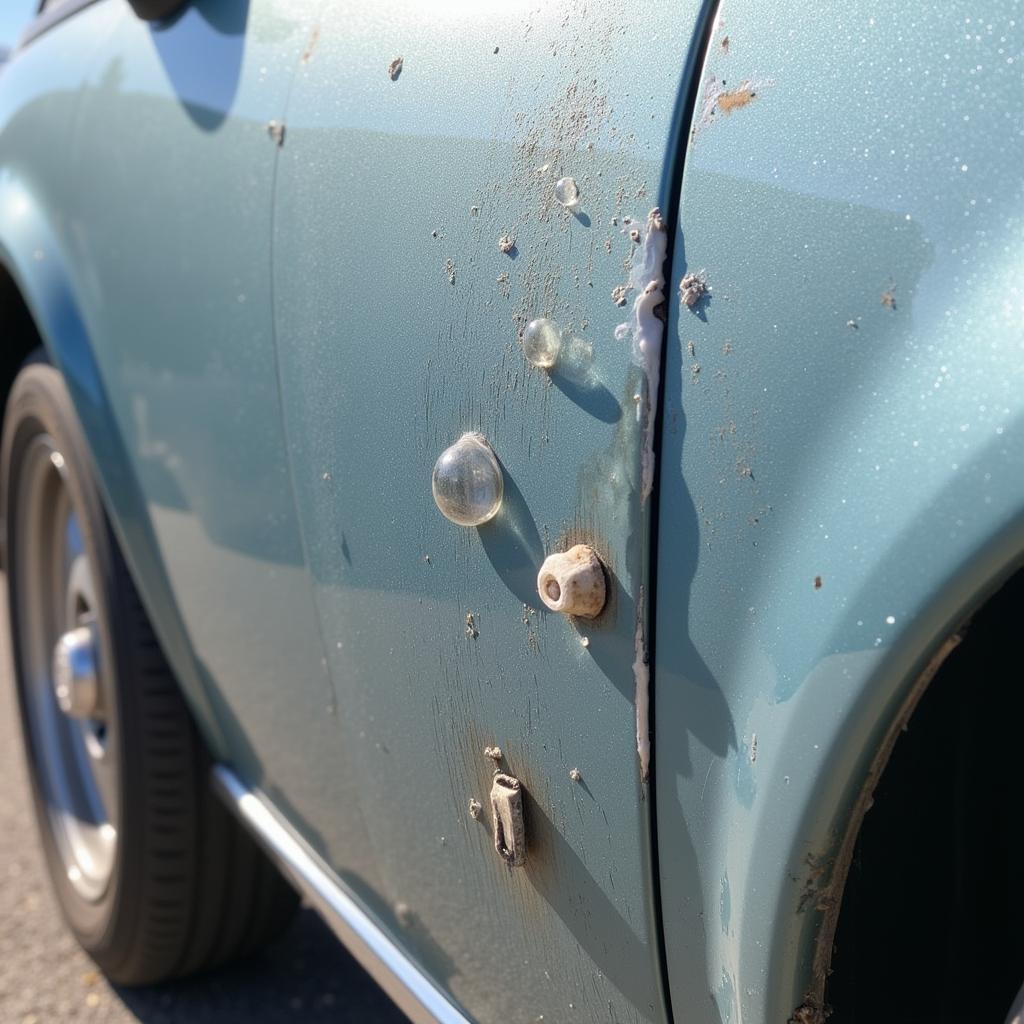Paint bubbles on your car are unsightly and can be a sign of more serious issues if left untreated. They occur when the paint film lifts away from the underlying surface, creating a small, raised bubble. This can be caused by a variety of factors, from poor paint application to environmental damage. This guide will walk you through the causes, prevention, and most importantly, how to fix paint bubbles on your car.
Similar to how to fix small paint bubbles on car, identifying the cause is the first step in fixing the issue.
Understanding the Causes of Paint Bubbles
Several factors can contribute to paint bubbling on a car. One common culprit is moisture. If water gets trapped beneath the paint layer, it can cause the paint to lift and bubble, especially in humid climates or after exposure to rain or flooding. Poor surface preparation before painting, such as inadequate cleaning or rust removal, can also lead to bubbling. Applying paint in direct sunlight or extreme temperatures can also create bubbles as the paint dries too quickly. Finally, impacts from rocks or other debris can chip the paint, allowing moisture to seep in and cause bubbling.
 Paint Bubbles Caused by Moisture
Paint Bubbles Caused by Moisture
How to Fix Paint Bubbles on Your Car
Addressing paint bubbles effectively requires the right tools and techniques. Here’s a step-by-step guide on how to fix paint bubbles on a car:
-
Assess the Damage: Carefully inspect the affected area to determine the extent of the bubbling. Note the size and number of bubbles.
-
Gather Your Supplies: You will need sandpaper (various grits), primer, touch-up paint that matches your car’s color, clear coat, masking tape, a plastic scraper or razor blade, rubbing compound, and polishing compound.
-
Prepare the Area: Wash and dry the area around the bubbles thoroughly. Use masking tape to protect the surrounding paint.
-
Remove the Bubbles: Carefully puncture the bubbles with the tip of a razor blade or plastic scraper. Gently scrape away the loose paint, taking care not to damage the underlying surface. If you discover rust underneath the paint, you’ll need to address that separately before proceeding. This often involves sanding down to bare metal and applying a rust converter.
-
Sand the Area: Start with a coarser grit sandpaper (e.g., 180-grit) to smooth out the edges of the affected area and feather the surrounding paint. Gradually move to finer grits (e.g., 320-grit, then 400-grit) to create a smooth surface for the primer.
-
Apply Primer: Apply a thin, even coat of automotive primer to the sanded area. Allow the primer to dry completely according to the manufacturer’s instructions.
-
Sand the Primer: Lightly sand the primed area with fine-grit sandpaper (e.g., 400-grit) to ensure a smooth surface for the paint.
-
Apply Touch-Up Paint: Carefully apply thin coats of touch-up paint to the primed area, allowing each coat to dry before applying the next. Avoid applying too much paint at once, as this can lead to runs and drips.
-
Apply Clear Coat: Once the touch-up paint is dry, apply a thin, even coat of clear coat to protect the paint and provide a glossy finish.
-
Sand and Polish: After the clear coat has dried completely, use rubbing compound and then polishing compound to blend the repaired area with the surrounding paint and achieve a smooth, even finish.
how to fix rust bubbles in car paint provides detailed information about handling rust, which is often a contributing factor to paint bubbles.
Preventing Paint Bubbles
Prevention is always better than cure. Regularly washing and waxing your car can help protect the paint from environmental damage. Addressing minor chips and scratches promptly can prevent moisture from penetrating the paint and causing bubbles. Parking your car in a garage or covered area can also help minimize exposure to the elements.
 Applying Touch-up Paint to Car
Applying Touch-up Paint to Car
Why is Proper Repair Important?
Ignoring paint bubbles can lead to more extensive damage, including rust formation and further paint deterioration. This can eventually require more costly repairs. Addressing bubbles promptly helps maintain the appearance and value of your car.
“Addressing paint bubbles quickly can save you a lot of money and hassle in the long run,” advises John Smith, an automotive repair specialist with over 20 years of experience. “It’s a small issue that can quickly escalate into a major problem if ignored.”
Conclusion
Fixing paint bubbles on your car is a manageable task that can be done with the right tools and techniques. By understanding the causes and following the steps outlined in this guide, you can effectively restore your car’s appearance and prevent further damage. how to fix rust bubbling paint on car offers more solutions to combatting rust and paint damage. For further assistance, connect with us at AutoTipPro. Our phone number is +1 (641) 206-8880, and our office is located at 500 N St Mary’s St, San Antonio, TX 78205, United States.
 Polished Car After Paint Repair
Polished Car After Paint Repair
easy way to fix rust on a car offers additional tips on rust removal and prevention.






Leave a Reply